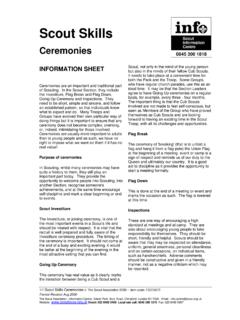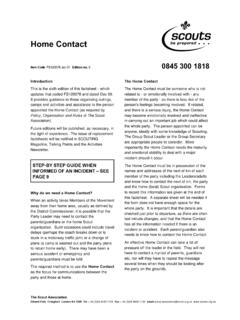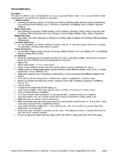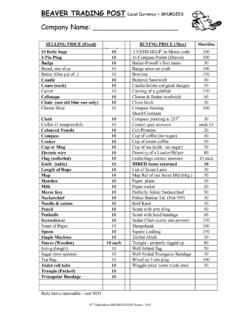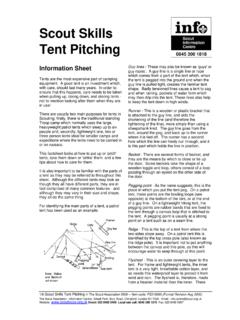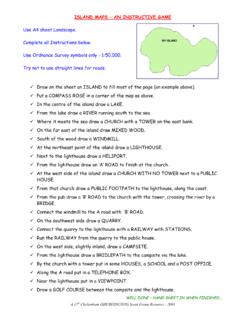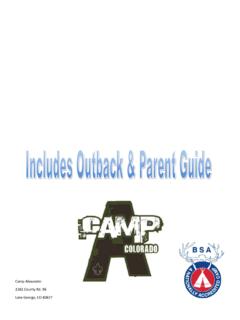Transcription of Campsite Layout and Selection - Fachsheet - …
1 1/7 Campsite Layout and Selection The scout Association 2000 Item code: FS315071 (Format Revision Aug 2000)The scout Association, Information Centre, Gilwell Park, Bury Road, Chingford, London E4 7QW. Email: Direct: 020 8498 5400 Local rate call: 0845 300 1818 Fax: 020 8498 5407 0845 300 1818 scout SkillsCampsite Layout andSelectionINFORMATION SHEETC amping is very much part of Scouting, anactivity undertaken by most Members at onetime or another during their ' scout life'. A lot oftime and effort can be invested in camping andso it is important to get it right for all good camp will be remembered for manyyears, and so will a bad one! A bad experiencecan put people off camping for life so it is ourresponsibility to try and ensure that all camps aresuccessful of the factors that will affect the success ofa camp are where you choose to camp - theplace and the environment, and the Layout of thesite - making sure that the basic facilities areavailable and well site selectionThere are local and National scout Camp sitesall over the United Kingdom and, of course, inother parts of the world.
2 A list of District,County/Area and National camping areas in theUnited Kingdom is published annually, and a listof sites and areas unsuitable for use by Membersof the Movement is issued annually to DistrictCommissioners. These publications can also bepurchased from Headquarters (InformationCentre at Gilwell Park).There are other sites and places such asNational Trust properties, privately owned landand public sites which can be used. However, allof these will need to be checked against theabove list and permission granted before settingup camp. If you wish to camp on common landor other local areas, make certain that local bye-laws do not prohibit camping. Scouts do nothave the right to camp anywhere they like!For camps of five nights' duration or longer,approval must be obtained from the homeDistrict Commissioner. This is done by theScouter responsible for the camp, submitting aForm PC, together with the registration fee atleast two months before the start of the allows the District Commissioner, who isresponsible for the standards of camping in theDistrict, to ensure that such suitable standardsare choice of where to camp depends on severalfactors; cost and accessibility of transport to getthere, the purpose of the camp (there's no pointin going to Brighton if you want to go mountainclimbing!)
3 , the time of the year and so on. Manyof these factors will have already beendetermined, and then it is necessary to startlooking at some of the other basic factors whichneed to be considered when looking for a placeto camp: Safe drinking water should be availablewithin a short distance. If none is availableor you are uncertain of the quality of thewater, the water should be boiled or purifyingtablets used. The site must be well drained and unlikely toflood. Avoid clay and peat soils and sitesadjacent to the sea, a river, or otherstretches of water. Make sure there is sufficient level ground forall tents and recreation areas. If a sunny aspect is preferred, the tentsshould be pitched facing south east to getthe morning sun. The site should have an adequate supply ofwood for open fires, if permitted, and for theconstruction of camp gadgets. Check that there is protection from theprevailing winds.
4 The site should be accessible for vehicles; aroad or track is therefore essential. Depending upon the purpose of the camp,facilities must exist for the camp's majoractivities. Beware of natural hazards. Do not campdirectly under large trees because of the2/7 Campsite Layout and Selection The scout Association 2000 Item code: FS315071 (Format Revision Aug 2000)The scout Association, Information Centre, Gilwell Park, Bury Road, Chingford, London E4 7QW. Email: Website Direct: 020 8498 5400 Local rate call: 0845 300 1818 Fax: 020 8498 5407risks of falling branches, a lightning strike orthe continual drip of water after rain hasstopped. Avoid overhanging cliffs with riskof falling rocks and rock slides. If you are backpacking, ensure that you willbe able to reach a site at least one hourbefore may not be possible to include all these factors- unless you have found the perfect site ofcourse!
5 You will need to decide what are themost important for your Site LayoutEvery site will be different, with varying facilitiesavailable. Whatever type of camp you areplanning, the Layout of your site is important sothat those taking part know where certain thingsare, how they are organised and how they canmake the most of the facilities available. Afterall, your site and its surroundings are going to behome for a while - don't make life toouncomfortable!Generally speaking, for a Troop camp, it is usualfor each Patrol to have its own 'self-sufficient'area. There should be two main areas clearlymarked:a) The central area containing the camp 'ser-vices' such as first aid, Quartermaster'sstores, notice board, water point, Leaders'tents, and so ) The Patrol areas which are individual sitesand should be easily accessible and yet self-contained. The boundaries of these shouldbe well-defined especially if there is not a lotof are then other factors which should betaken into consideration when placing tents andother facilities or amenities.
6 There are no hardand fast rules as it will of course depend on theindividual occasion, however the following chartmay give some suggestions:For mixed camps, males and females will needseparate sleeping, washing, and toilet will need to think carefully where you putthese to maintain &ShelterLighting(Lamp)DrainedDownwindIde al PositionFirst AidTent Centre of camp andaccessibleDiningShelter Close to kitchen to stop foodgoing cold, but not in linewith smoke from Positioned so that smoke willnot blow into camp and thedining shelterLatrines Downwind of the camp itself,but not too Positioned between latrinesand campChoppingAreaRoped off from rest of to woodpile butwoodpile not too close If possible, positioned whereany spilt water can bedrained Positioned so that wind doesnot blow through tent Campsite Layout and Selection The scout Association 2000 Item code.
7 FS315071 (Format Revision Aug 2000)The scout Association, Information Centre, Gilwell Park, Bury Road, Chingford, London E4 7QW. Email: Website Direct: 020 8498 5400 Local rate call: 0845 300 1818 Fax: 020 8498 5407 Further information andresourcesAsk other Leaders in the Group or Districtabout their experiences of different ones would they consider going back toand why?As previously mentioned, publications areavailable from Headquarters listing suitableand unsuitable camping the District or County Secretary for thearea that you are interested in. They may beable to advise you about local the your AAC/ACC (International) orInternational Office at Gilwell Park if you areconsidering camping Campsite Layout and Selection The scout Association 2000 Item code: FS315071 (Format Revision Aug 2000)The scout Association, Information Centre, Gilwell Park, Bury Road, Chingford, London E4 7QW.
8 Email: Website Direct: 020 8498 5400 Local rate call: 0845 300 1818 Fax: 020 8498 5407 TEACH YOURSELFK nowledge and understanding of camp siteselection and Layout can really only be gainedby experience. However, by using amethodical approach and carefully consideringthe appropriate factors, you can usefully startto plan your all about itBefore having a go, you will need to have readthe Information Sheet if you have not alreadydone site Selection - The first method bywhich you can find out about selecting a Campsite , is to talk with other Leaders who havethemselves been camping on various may either be able to give yousuggestions for specific sites or some generaladvice as to what to look for. Base yourdiscussions on a checklist of criteria, such asthe one outlined second method, and probably the mostvaluable thing you can do, is to visit any pro-posed camp site.
9 It is very important that youensure that it is suitable and provides thefacilities that you require and by seeing it foryourself, you can make full use of the ameni-ties. If it is possible, it will be useful to see thesite in, or shortly after, poor weather conditionsto give you a realistic idea of what you mighthave to cope with!So, when visiting a camp site, it is important tocollect as much information as with the criteria outlined in theInformation Sheet, you may like to considerthe following points: Call on local people who may be requiredduring your camp and check that they willbe able to offer help should you need example, a doctor or minister. Find out about local events that might behappening during your stay. These couldthen either be incorporated in theprogramme or avoided! Make contact with local organisations: scout Group, Guide Company, and so on.
10 Find out the location of the nearest church,hospital, police station and other local ser-vices. Take photographs or slides of the area andsite to show to Members, other Leadersand perhaps parents. Check what food and dairy supplies can beobtained locally and the end of this section there is a Camp SiteChecklist which may be useful for recordinginformation. Alternatively, you could designyour site Layout - Again, if you are in aposition to see the site, this will give you amuch better idea of how the site may beorganised. However, even without seeing it,you will be able to design a Layout plan, usingthe criteria outlined in the Information some stage, you will know what equipmentyou need to take, how many Patrol tents toinclude, and so first method is a simple sketch map,drawn to an approximate scale. For example,one centimetre equals one metre. This willgive you an idea of the space that you mayhave available.
